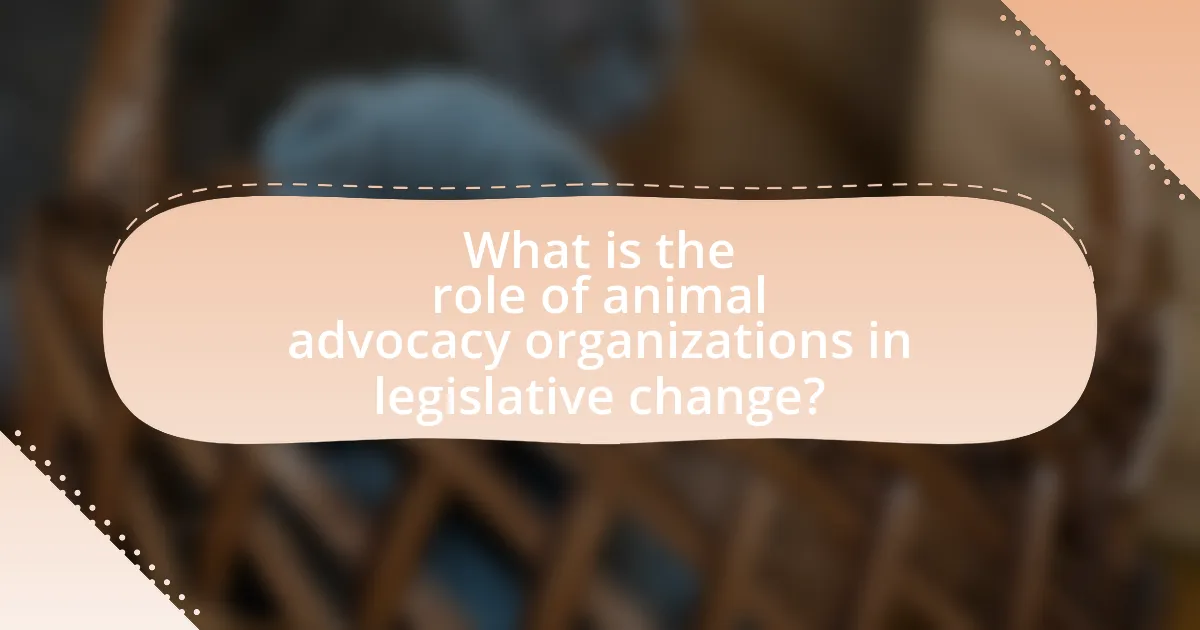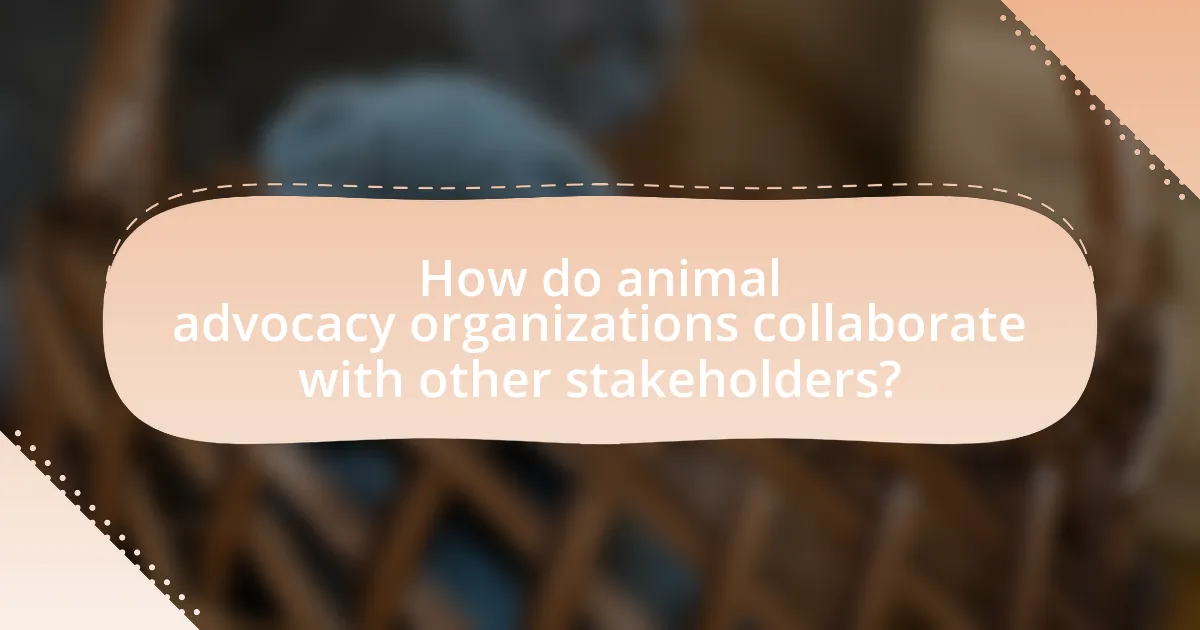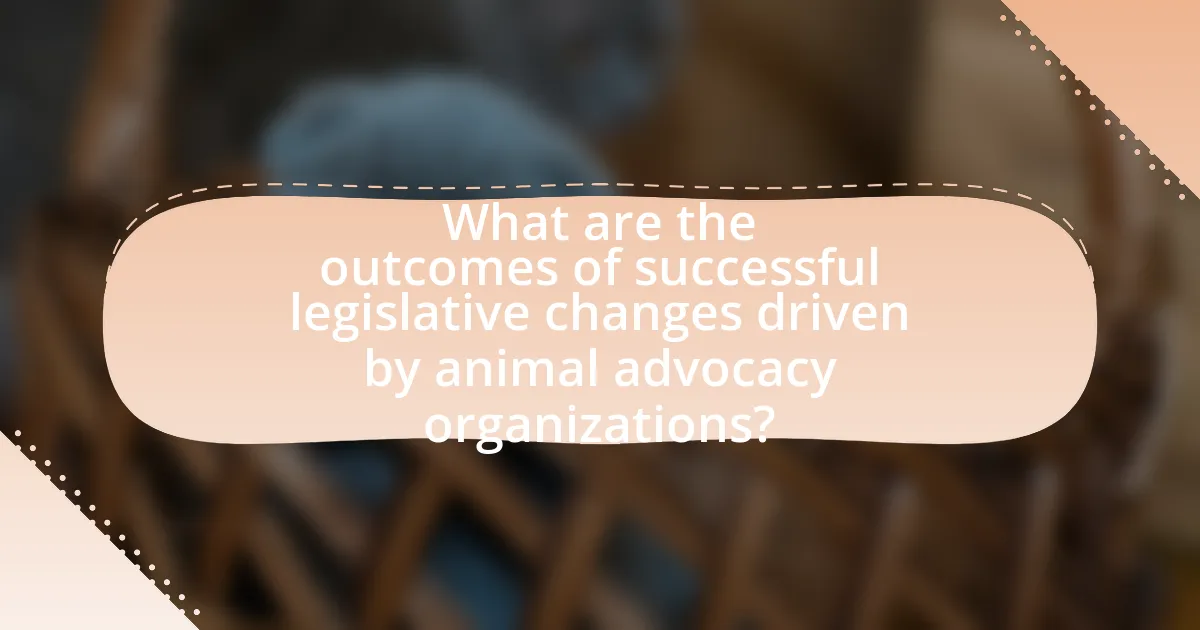Animal advocacy organizations play a vital role in driving legislative change to protect animal rights and welfare. They engage in lobbying, public awareness campaigns, and grassroots mobilization to influence policymakers and enact laws such as the Animal Welfare Act. These organizations face challenges, including political opposition and limited resources, yet they collaborate with various stakeholders to enhance their advocacy efforts. The article examines the strategies employed by these organizations, their impact on animal welfare laws, and the lessons learned from successful campaigns, highlighting their significant contributions to improving the lives of animals through legislative reforms.

What is the role of animal advocacy organizations in legislative change?
Animal advocacy organizations play a crucial role in legislative change by lobbying for laws that protect animal rights and welfare. These organizations engage in various activities, such as conducting research, mobilizing public support, and providing expert testimony to influence policymakers. For instance, the Humane Society of the United States has successfully advocated for legislation like the Animal Welfare Act, which sets standards for the treatment of animals in research and exhibition. Their efforts often include grassroots campaigns that raise awareness and encourage citizens to contact their representatives, thereby amplifying their impact on legislative processes.
How do animal advocacy organizations influence legislation?
Animal advocacy organizations influence legislation primarily through lobbying efforts, public awareness campaigns, and grassroots mobilization. These organizations engage with lawmakers to advocate for animal welfare laws, often providing research, expert testimony, and case studies that highlight the need for legislative change. For example, the Humane Society of the United States has successfully lobbied for laws that ban puppy mills and improve conditions for farm animals, demonstrating their impact on policy. Additionally, these organizations mobilize public support through campaigns that raise awareness about animal rights issues, which can pressure legislators to act in favor of animal welfare. This combination of direct advocacy and public engagement creates a significant influence on the legislative process.
What strategies do these organizations employ to advocate for change?
Animal advocacy organizations employ strategies such as grassroots mobilization, lobbying, public education campaigns, and coalition-building to advocate for change. Grassroots mobilization involves engaging community members to participate in demonstrations and petitions, which can amplify their voices and influence policymakers. Lobbying efforts focus on directly interacting with legislators to promote animal welfare legislation, often supported by data on animal cruelty and public sentiment. Public education campaigns raise awareness about animal rights issues, utilizing social media and traditional media to inform the public and garner support. Coalition-building with other organizations enhances their reach and effectiveness, allowing for a united front on legislative initiatives. These strategies collectively contribute to significant legislative changes, as evidenced by the passage of laws such as the Animal Welfare Act and various state-level animal protection laws.
How do they mobilize public support for legislative initiatives?
Animal advocacy organizations mobilize public support for legislative initiatives through strategic campaigns that include grassroots organizing, public awareness campaigns, and coalition building. These organizations often utilize social media platforms to disseminate information rapidly, engage supporters, and encourage them to contact legislators. For instance, the Humane Society of the United States has successfully mobilized thousands of individuals to participate in advocacy days, where constituents meet with lawmakers to discuss animal welfare issues. Additionally, research indicates that public petitions and letter-writing campaigns can significantly influence legislative outcomes, as demonstrated by the success of the Animal Welfare Act amendments, which garnered widespread public support.
Why are animal advocacy organizations important in the legislative process?
Animal advocacy organizations are important in the legislative process because they influence policy decisions that protect animal welfare. These organizations mobilize public support, provide expert testimony, and lobby lawmakers to enact legislation that addresses issues such as animal cruelty and habitat preservation. For instance, the Humane Society of the United States has successfully advocated for laws that ban puppy mills and improve conditions for farm animals, demonstrating their effectiveness in shaping animal-related legislation.
What impact do they have on animal welfare laws?
Animal advocacy organizations significantly influence animal welfare laws by lobbying for stronger regulations and raising public awareness about animal rights issues. These organizations often conduct research, provide expert testimony, and mobilize grassroots campaigns to advocate for legislative changes that protect animals. For example, the Humane Society of the United States has played a crucial role in the passage of various animal welfare laws, including the Animal Welfare Act amendments, which enhance protections for animals in research and breeding. Their efforts have led to increased public support for animal welfare legislation, resulting in more stringent laws and enforcement mechanisms across various jurisdictions.
How do they contribute to raising awareness about animal rights?
Animal advocacy organizations contribute to raising awareness about animal rights by conducting educational campaigns that inform the public about animal welfare issues. These organizations utilize various platforms, including social media, public events, and educational materials, to disseminate information on the ethical treatment of animals and the impact of legislation on animal rights. For instance, organizations like the Humane Society of the United States have successfully mobilized public support for animal protection laws, leading to significant legislative changes. Their efforts often include statistics and research findings that highlight the conditions faced by animals in various industries, thereby fostering a more informed and compassionate public perspective on animal rights.
What challenges do animal advocacy organizations face in legislative change?
Animal advocacy organizations face significant challenges in achieving legislative change, primarily due to political opposition and limited resources. Political opposition often arises from industries that benefit from animal exploitation, such as agriculture and entertainment, which lobby against animal welfare legislation. Additionally, these organizations frequently operate with constrained budgets and manpower, limiting their ability to effectively campaign and mobilize public support. For instance, a study by the Animal Welfare Institute highlights that many advocacy groups struggle to compete with the financial power of pro-industry lobbyists, making it difficult to influence lawmakers. Furthermore, public awareness and engagement can be inconsistent, as animal welfare issues may not always resonate with voters compared to other pressing social issues, complicating advocacy efforts.
How do political opposition and lobbying affect their efforts?
Political opposition and lobbying significantly impact the efforts of animal advocacy organizations in legislative change by shaping the political landscape and influencing decision-makers. Political opposition can hinder the passage of animal welfare legislation by mobilizing counterarguments and resources against proposed reforms, as seen in instances where agricultural and pharmaceutical industries lobby against stricter animal welfare laws. For example, in 2019, the American Veterinary Medical Association opposed certain animal welfare bills, arguing they could negatively affect veterinary practices. Lobbying efforts by animal advocacy organizations, such as the Humane Society Legislative Fund, aim to counteract this opposition by promoting pro-animal legislation and mobilizing public support. Their effectiveness is often measured by the ability to secure legislative victories, such as the passage of the Animal Welfare Act amendments, which were influenced by sustained lobbying efforts and public awareness campaigns.
What are the limitations of their influence on legislation?
Animal advocacy organizations face several limitations in their influence on legislation. Primarily, these organizations often lack the financial resources and political connections that larger lobbying groups possess, which can hinder their ability to effectively advocate for animal rights. Additionally, public opinion can be divided on animal welfare issues, making it challenging for these organizations to garner widespread support for specific legislative changes. Furthermore, legislative processes can be slow and complex, with multiple stakeholders involved, which can dilute the impact of advocacy efforts. For instance, despite significant campaigning, the passage of comprehensive animal welfare laws can take years, as seen in the lengthy debates surrounding the Animal Welfare Act amendments.

How do animal advocacy organizations collaborate with other stakeholders?
Animal advocacy organizations collaborate with other stakeholders through partnerships, coalitions, and advocacy campaigns to promote legislative change. These organizations often work with government agencies, non-profits, and community groups to align their goals and resources, enhancing their influence on policy-making. For instance, the Humane Society of the United States collaborates with local governments to implement animal welfare laws, demonstrating effective stakeholder engagement. Additionally, research shows that coalitions can amplify the voices of animal advocates, leading to successful legislative outcomes, such as the passing of animal protection laws in various states.
What partnerships do these organizations form to enhance their impact?
Animal advocacy organizations form partnerships with governmental bodies, non-profit organizations, and community groups to enhance their impact on legislative change. These collaborations allow for the pooling of resources, sharing of expertise, and mobilization of public support, which are crucial for effective advocacy. For instance, organizations like the Humane Society of the United States often partner with local animal shelters and veterinary associations to promote animal welfare legislation, leveraging their collective influence to drive policy changes. Such strategic alliances have been shown to increase the likelihood of successful legislative outcomes, as evidenced by the passage of laws aimed at improving animal protection standards in various states.
How do collaborations with other NGOs strengthen advocacy efforts?
Collaborations with other NGOs strengthen advocacy efforts by pooling resources, expertise, and networks to amplify their collective impact. When multiple organizations unite, they can share knowledge and strategies that enhance their ability to influence policy and public opinion. For instance, a coalition of animal advocacy organizations can leverage their combined membership numbers to demonstrate widespread support for legislative changes, making it more compelling for lawmakers to act. Research shows that collaborative efforts often lead to more comprehensive campaigns, as seen in the successful passage of animal welfare laws in various regions, where joint initiatives have resulted in increased visibility and public engagement.
What role do coalitions play in legislative campaigns?
Coalitions play a crucial role in legislative campaigns by uniting various stakeholders to amplify their influence and resources. These alliances enable animal advocacy organizations to pool their expertise, funding, and grassroots support, thereby enhancing their ability to advocate for specific legislative changes. For instance, coalitions can effectively mobilize public opinion and create a stronger lobbying presence, which is evidenced by successful campaigns such as the passage of the Animal Welfare Act amendments, where multiple organizations collaborated to push for more stringent regulations. This collaborative approach not only increases visibility but also fosters a unified message that resonates with lawmakers, ultimately leading to more effective legislative outcomes.
How do animal advocacy organizations engage with lawmakers?
Animal advocacy organizations engage with lawmakers primarily through lobbying efforts, grassroots campaigns, and public awareness initiatives. These organizations often employ lobbyists to directly communicate with legislators, presenting research and data that support animal welfare legislation. For instance, the Humane Society Legislative Fund reported that in 2020, they successfully lobbied for the passage of the PACT Act, which prohibits animal cruelty in interstate commerce. Additionally, these organizations mobilize supporters to contact their representatives, amplifying their message and demonstrating public support for animal protection laws. This combination of direct lobbying and grassroots activism effectively influences legislative agendas and outcomes related to animal welfare.
What methods do they use to communicate their positions to legislators?
Animal advocacy organizations communicate their positions to legislators primarily through direct lobbying, grassroots campaigns, and public awareness initiatives. Direct lobbying involves meeting with legislators to present research, data, and personal stories that highlight the importance of animal welfare legislation. Grassroots campaigns mobilize supporters to contact their representatives, often using social media and email campaigns to amplify their message. Public awareness initiatives, such as educational events and media outreach, help to shape public opinion and create a supportive environment for legislative change. These methods are effective as they engage both legislators and the public, fostering a collaborative approach to animal advocacy.
How do they build relationships with key political figures?
Animal advocacy organizations build relationships with key political figures through strategic lobbying, grassroots mobilization, and coalition-building efforts. These organizations often engage in direct communication with legislators, providing them with research, data, and personal stories that highlight the importance of animal welfare issues. For instance, organizations like the Humane Society of the United States have successfully influenced legislation by organizing meetings with lawmakers, participating in public hearings, and mobilizing supporters to contact their representatives. This approach not only raises awareness but also demonstrates public support for animal welfare, making it more likely that political figures will prioritize these issues in their agendas.

What are the outcomes of successful legislative changes driven by animal advocacy organizations?
Successful legislative changes driven by animal advocacy organizations result in enhanced animal welfare protections, reduced animal cruelty, and improved regulations on animal industries. For instance, the passing of the Animal Welfare Act in the United States has led to increased standards for the care and treatment of animals in research, exhibition, and transport. Additionally, the enactment of laws banning puppy mills in various states has directly decreased the number of animals subjected to inhumane breeding practices. These outcomes demonstrate the tangible impact of advocacy efforts, as evidenced by the significant legislative reforms that have emerged from sustained campaigns and public awareness initiatives led by these organizations.
How do these changes affect animal welfare standards?
Changes in legislation driven by animal advocacy organizations significantly enhance animal welfare standards. These organizations advocate for stricter regulations that improve living conditions, reduce suffering, and promote humane treatment of animals. For instance, the passage of laws banning certain cruel practices, such as gestation crates for pigs, directly results from advocacy efforts and leads to better welfare outcomes. Research indicates that states with stronger animal welfare laws report lower instances of animal cruelty and improved conditions in farming practices, demonstrating the positive impact of these legislative changes on animal welfare standards.
What specific laws have been influenced by animal advocacy organizations?
Animal advocacy organizations have influenced several specific laws, including the Animal Welfare Act, the Humane Slaughter Act, and various state-level anti-cruelty laws. The Animal Welfare Act, enacted in 1966, was significantly shaped by advocacy efforts to ensure humane treatment of animals in research and exhibition. The Humane Slaughter Act, passed in 1958, was influenced by campaigns to improve conditions for animals in the meat industry. Additionally, numerous state-level anti-cruelty laws have been enacted or strengthened due to lobbying and public awareness campaigns led by these organizations, resulting in more stringent penalties for animal abuse and neglect.
How do legislative changes improve the lives of animals?
Legislative changes improve the lives of animals by establishing legal protections that prevent cruelty and exploitation. For instance, laws such as the Animal Welfare Act in the United States set standards for the care and treatment of animals in research, exhibition, and transport, thereby reducing instances of neglect and abuse. Additionally, legislation banning specific practices, such as puppy mills or the use of animals in circuses, directly enhances animal welfare by eliminating harmful environments and practices. These legal frameworks are often influenced by advocacy organizations that raise awareness and lobby for stronger protections, demonstrating the significant impact of legislative changes on animal lives.
What lessons can be learned from successful advocacy campaigns?
Successful advocacy campaigns demonstrate the importance of clear messaging and strategic coalition-building. Clear messaging ensures that the campaign’s goals resonate with the target audience, as seen in the “Be Kind to Animals” campaign, which effectively communicated the ethical treatment of animals. Strategic coalition-building, exemplified by the collaboration between various animal rights organizations, amplifies resources and influence, leading to significant legislative changes, such as the passing of the Animal Welfare Act. These campaigns also highlight the necessity of data-driven approaches, where statistics on animal suffering can mobilize public support and sway policymakers.
What best practices can other organizations adopt from these successes?
Organizations can adopt the best practice of strategic coalition-building from the successes of animal advocacy organizations in legislative change. By forming alliances with diverse stakeholders, such as environmental groups, public health organizations, and community leaders, these advocacy groups have amplified their influence and broadened their reach. For instance, the Humane Society of the United States successfully partnered with various organizations to pass the Animal Welfare Act amendments, demonstrating that collaborative efforts can lead to significant legislative victories. This approach not only enhances resource sharing but also fosters a united front that can effectively advocate for policy changes.
How can future campaigns be designed for greater effectiveness?
Future campaigns can be designed for greater effectiveness by utilizing data-driven strategies that target specific demographics and issues. By analyzing past campaign performance and audience engagement metrics, organizations can identify which messages resonate most with their target audience. For instance, a study by the Pew Research Center found that tailored messaging significantly increases engagement rates, with campaigns that address specific concerns of the audience achieving up to 50% higher response rates. Additionally, incorporating social media analytics allows organizations to adapt their strategies in real-time, ensuring that campaigns remain relevant and impactful.